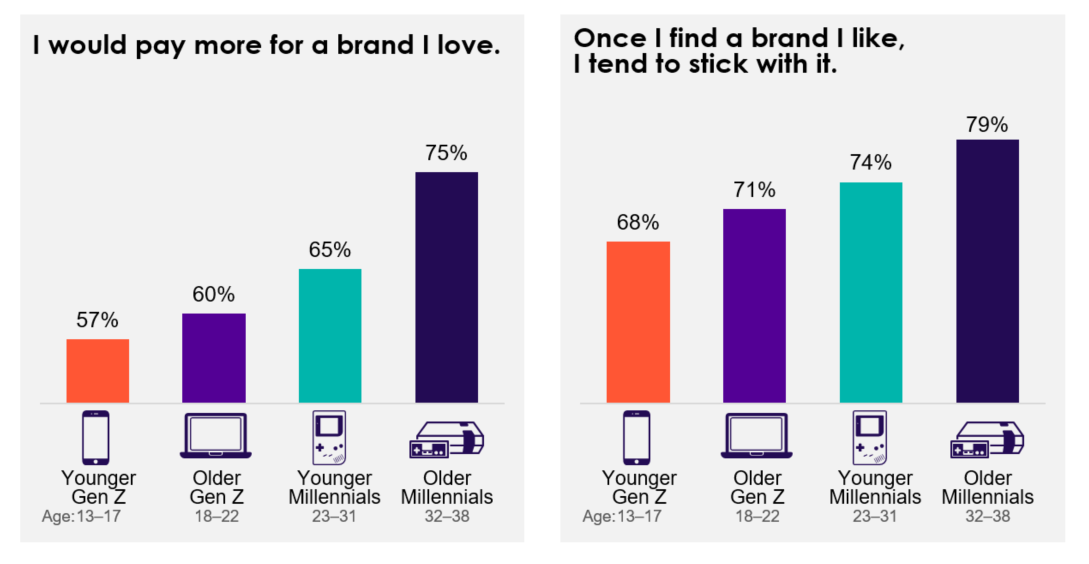
For years, brands have been talking about how millennials are different from other generations and require a unique approach to messaging, advertising, product development and purchase experiences. millennials—born between 1980 and 1996—were the trendsetters, and brands have invested in countless ways to capture their attention and loyalty, shifting with them as their needs and the world’s technology have changed.
But are all millennials really the same?
We know from articles in recent years that the oldest millennials often feel like they don’t quite fit in with the media’s portrayal of their generation. Yet many brands still lump all millennials together by values, motivations and behaviors when developing marketing and communication plans.
That’s a lost opportunity, and here’s why:
In a recent generational study, Escalent set out to learn more about the needs and values of different cohorts within the millennial generation. Our hypothesis was that the age of millennials during the Great Recession—late 2007 to mid-2009—is a dividing factor for how millennials approach the world. For example, millennials in or entering the workforce during that time would have viewed things differently from their middle school- and high school-aged counterparts.
We found that there are, in fact, nuances between younger (age 23-31) and older (age 32-38) millennials that impact how brands should approach and communicate with this generation. Interestingly, by comparing millennials in a different way, the results also shed light on how brands can better prepare for the influx of Gen Z to the marketplace.
During the current global health and economic crisis, it is all the more important for brands to understand the nuances between the two cohorts within the millennial generation and Gen Z trends. Here are our findings, along with recommendations for how brands can ensure they’re delivering the right messages to the right people.
Different Events Have Influenced Different Millennials
Older millennials entered or were in the workforce in the throes of the Great Recession. High unemployment and stagnant wages led to a financial crisis that slowed down their earning potential, saddled them with high student debt, and affected their life choices for years to come. With the ongoing COVID-19 pandemic, older millennials are being transported back to the Great Recession, and acting accordingly by limiting their spending and consumption habits to pay for necessities. Younger millennials may finally understand just what their older counterparts went through as they all navigate the current crisis. Furthermore, older Gen Z are finding themselves in a similar situation to older millennials during the Great Recession—graduating from college with a lot of student loan debt and entering the workforce while the world is crippled by pandemic-related restrictions, high unemployment rates and extreme economic uncertainty.
Technology is another factor that has shaped the lives of millennials, in particular. Because technology has changed so rapidly over the years, there’s a big difference in culture and lifestyle between the youngest and the oldest millennials. For example, younger millennials grew up with the Internet and social media, whereas these technologies didn’t become a part of the lifestyle of older millennials until they became adults. In fact, older millennials have been grouped with the youngest Gen Xers in a microgeneration called Xennials. Born in the late 70’s to early 80’s, this group is said to have had an analog childhood and a digital adulthood. With a majority of the country grappling with varying levels of in-person restrictions and remote work, people of all generations are turning to different technologies to bridge the social distancing gap and maintain communication and connection—technologies with which Gen Z and younger millennials are well accustomed to regularly using.
Brand Love and Loyalty
Brand love and loyalty is not the same across all millennials. While many articles lament the loss of loyalty among millennials, our research shows that older millennials have a significant amount of brand loyalty and brand love. This includes paying more for their favorite brands, and sticking with a brand once they’ve found one they like.
At the same time, we found that Gen Zs appear to be like the younger, less loyal millennials. In fact, our data show a steady decline from older millennials to younger Gen Z across various brand love and loyalty measures.
Older millennials (age 32-38 in 2019) have the most brand love and loyalty.

Confidence and Connection
According to our research, older millennials feel more connected to products they buy and use, and are more self-assured and confident in what they want than their younger cohorts. Although confidence may come with age, we believe it ties more closely to brand behavior and loyalty. If someone feels connected and has more brand love, they’re more likely to be invested personally and stick with that brand.
The data show that while older millennials stand apart on these issues, Gen Z are following patterns of younger millennials.

How Brands Can Reach Millennials More Effectively
It’s important to recognize that just because millennials are grouped in the same generation, they’re not all the same people—especially when it comes to brand loyalty. You need to think about more than just the generation and take into account the cultural and economic shifts that happened and shaped millennials.
Here are three recommendations for brands to keep in mind:
- Adjust your strategy: If your target is all millennials, you need a two-prong strategy to reach both older and younger members of the group.
- Change up your tone: Adjust your tone to match the values and preferences of older and younger millennials so your message doesn’t fall flat.
- Modify your messaging: Target your messaging accordingly for each cohort. For example, older millennials want messaging that makes them feel connected to a product and reflects their core values.
Sharpen Your Brand Communication
Older and younger millennials aren’t so drastically different that they are different generations. However, there are definite nuances you should be aware of that can help your marketing become more effective. Both younger and older millennials will require a different strategy and tone when it comes to communicating with them and establishing brand love and loyalty. You’ll have to prove the need for loyalty to younger millennials while older millennials are more naturally inclined to be loyal to your brand.
As for Gen Z, they’re still defining themselves and are following in the footsteps of younger millennials. By tweaking your approach to strategy, tone and messaging, you’ll go a long way in establishing the trust needed to keep these important generations coming back again and again to your brand.
Send us a note to learn how Escalent can help you better understand your audiences and adjust your brand messaging strategy accordingly.
Escalent interviewed a national sample of 1004 consumers aged 13 to 38 between June 25 to July 2, 2019. Respondents were recruited from the Full Circle Research opt-in online panel of US adults and were interviewed online. The data were weighted by age, gender, and census region to match the demographics of the US population. The sample for this research comes from an opt-in, online panel. As such, any reported margins of error or significance tests are estimated, and rely on the same statistical assumptions as data collected from a random probability sample. Escalent will supply the exact wording of any survey question upon request.
Originally published April 16, 2020. Last updated February 4, 2021.










